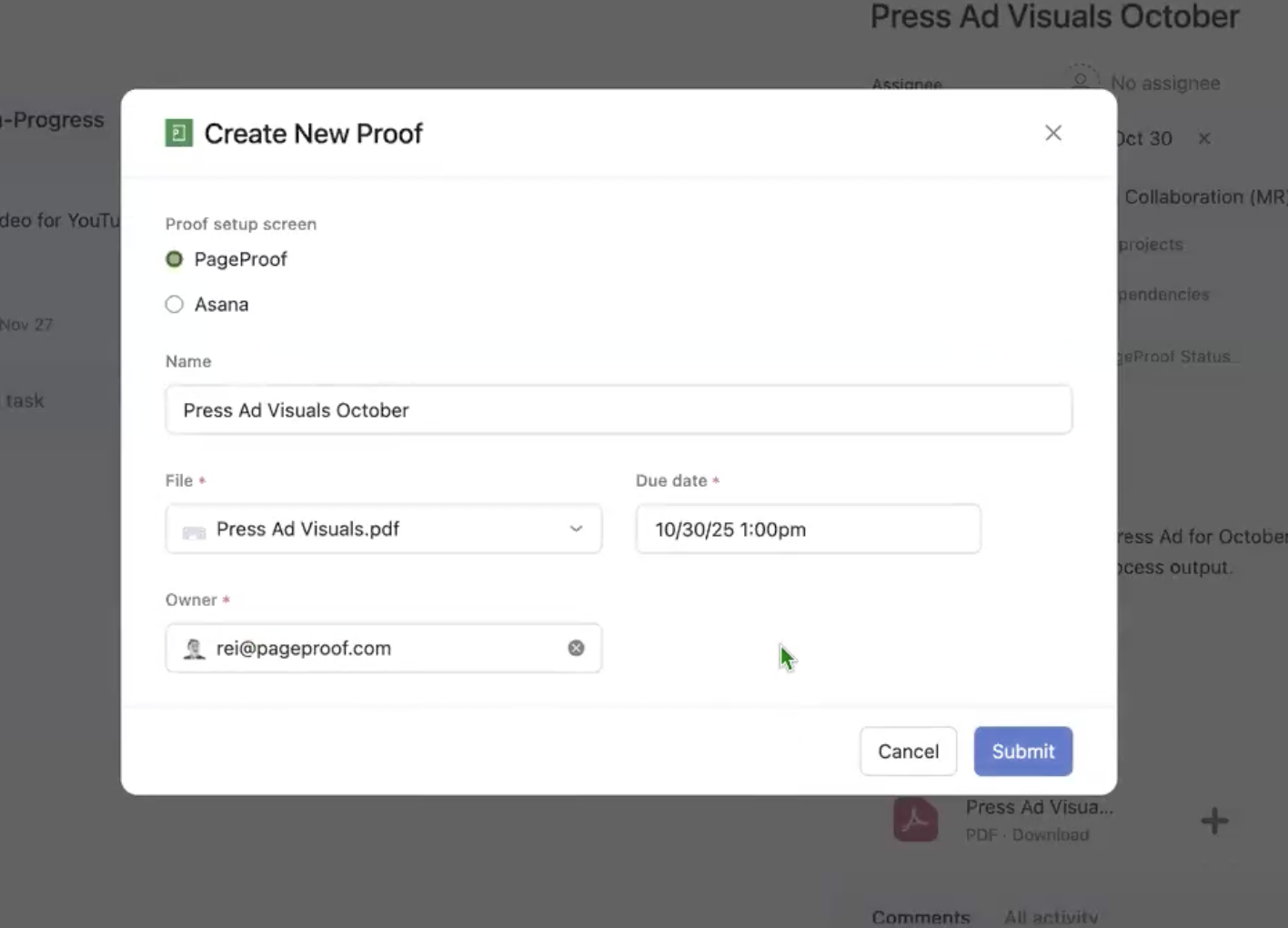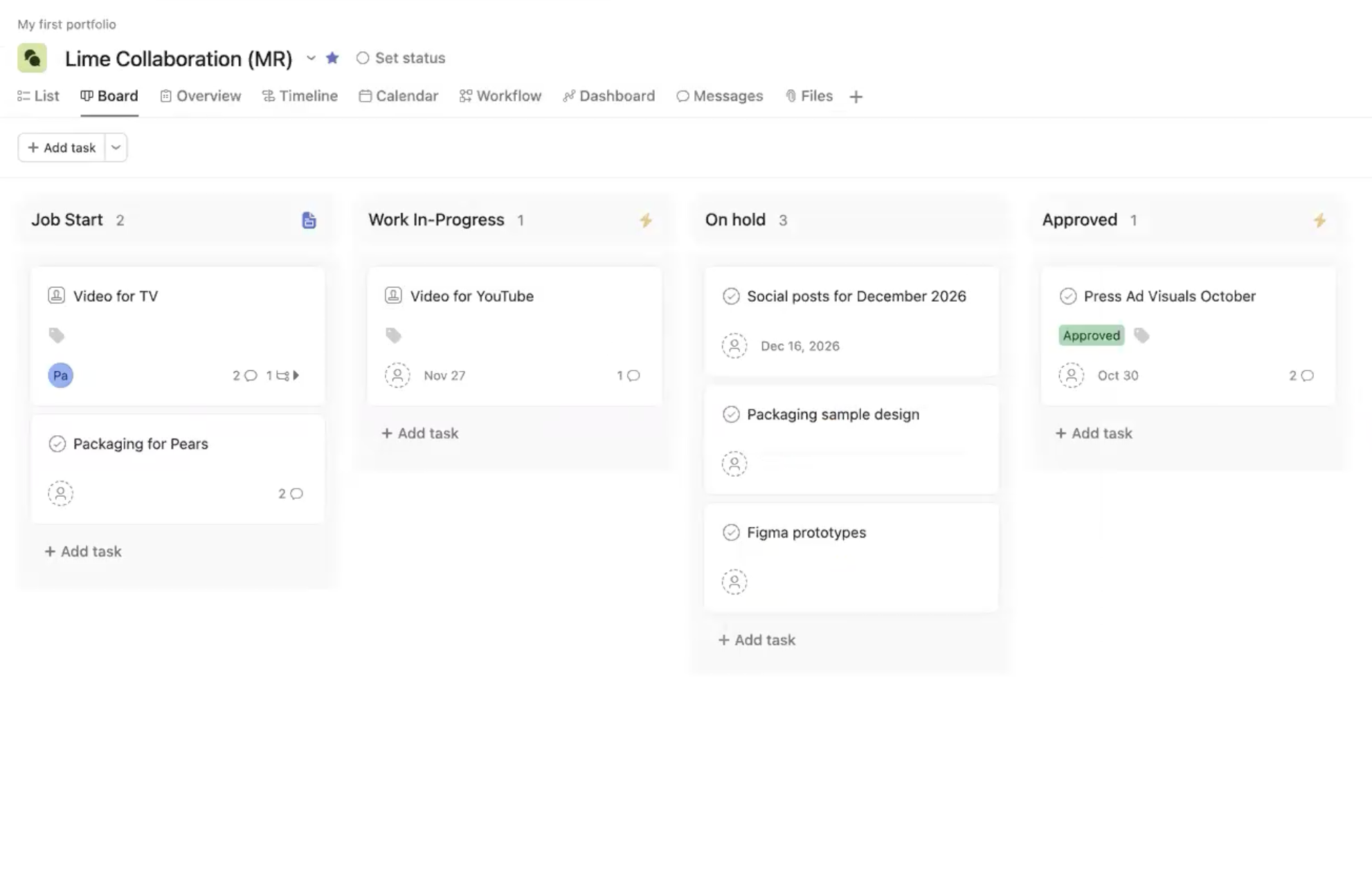Which Online Proofing Software Works Best with Asana? (PageProof Review)
TL;DR
Online proofing software like PageProof transforms creative approval chaos into automated workflows when integrated with Asana. As Marketing lead at Cirface, I got tired of chasing feedback across Slack, email, and Asana comments (you name it!)….so I tested PageProof to see if it actually lived up to the hype. Turns out, it does. We've cut 2-4 hours of weekly admin work, centralized all our feedback in one place, and finally solved our version control nightmares. After seeing what it did for our internal team, we started recommending it to our customers and their creative teams. Here's what we learned.
📋 Table of Contents
Jump to any section to learn about online proofing software for Asana workflows
What Is Online Proofing Software and Why Asana Needs It?
Online proofing software centralizes design review, feedback, and approval in one place. While Asana tracks what needs to happen and when, design proofing software tracks how creative work gets reviewed and approved.
But there’s a disconnect. Asana is brilliant for task management but wasn't built for visual feedback, version comparison, or sequential approvals. Without integration, you're the human API manually copying feedback from PageProof (or email, or Slack) into Asana tasks.
With integration, Asana becomes your command center. When feedback comes in through PageProof, your Asana task status updates automatically. When all stakeholders approve, the task moves to "Approved" without anyone touching it. The final approved file attaches itself to the Asana deliverable.
When Asana's Native Proofing Falls Short
Asana's built-in proofing works fine for lightweight feedback, typically for quick input from one or two people on simple assets. But for multi-stakeholder approvals, version control across 8+ rounds, or legal sign-offs… you'll hit its ceiling fast.
What native Asana proofing doesn't support:
Sequential approval workflows: You can't route proofs through Creative Director → Brand Manager → Legal → VP sign-off. Everyone reviews simultaneously, wasting time on feedback that upstream reviewers would have caught (a thing of nightmares for creative ops.)
Pixel-perfect version comparison: When you upload version 7, stakeholders can't see exactly what changed from version 6. PageProof's smart compare shows changes on a pixel level, highlighting every modification automatically.
Technical file validation: Print work, packaging, or production files need color profile, embedded font, and bleed validation. Asana can't verify if your PDF is missing a color profile or using wrong fonts.
External reviewer access without licenses: Your agency partners, freelance designers, and client stakeholders don't have Asana licenses. With creative proofing software, external reviewers get email notifications and can leave feedback without needing a login or even a license.
If you're managing creative approvals with native Asana tools and wondering why everything feels like manual overhead… you've outgrown the tool's proofing capabilities. And this, undoubtedly, incurs a cost.
How Much Is Approval Chaos Actually Costing You?
Running creative approvals without proper online proofing software isn't free, because the costs hide in places you're not tracking: wasted hours, preventable errors, and team burnout.
The Weekly Time Drain
Let’s do the math, shall we.
45 minutes per week chasing people to review work. "Can you review this?" via Slack. No response. Follow-up email two days later. Still nothing. Finally, a direct message: "We're blocked and we need your approval!!!"
1.5 hours per week consolidating feedback from Slack, email, and meetings. Brand manager comments in email. Creative director marks up a PDF in Slack. Someone gives verbal feedback in stand-ups. You spend Tuesday morning creating a single feedback document because designers can't work from five different sources.
2 hours per week creating status reports. Your VP wants to know what's blocked, what's in review, what's approved. That information lives across PageProof, email threads, and Slack. You manually compile Monday morning update decks.
The math: For a team of 5 creatives + 3 stakeholders, that's 12-15 hours per week = 624-780 hours per year spent purely on process overhead. At $75/hour (conservative for mid-level ops roles), you're spending $46,800-$58,500 annually just managing approvals manually.

There is a term in creative 'herding cats' or chasing people to look at my work. Automated reminders are a deterrent and a way of keeping everybody on task when it comes to your proofing.
The Errors That Slip Through
Without structured creative proofing software, three error types become inevitable:
Wrong versions go live. Someone approved version 7 via email while the designer worked on version 9. The wrong file goes to print because no one had a single source of truth.
Feedback gets missed. Buried in an email thread with 47 replies or lost in a Slack channel. The designer moves forward, only to hear in the final review that these notes were flagged two weeks ago.
Compliance issues slip through. Worse of all, there’s no audit trail of who approved what and when. Legal thought Brand approved the disclaimer, brand assumed Legal signed off and neither actually did.
Why Your Team Feels Burnt Out
Burnout in creative ops isn't really a workload volume issue. It’s really a workload friction problem. When every approval requires six manual steps (upload file, notify stakeholders, chase non-responders, consolidate feedback, update Asana status, re-notify for next round), people feel like they're pushing a boulder uphill.
Remove the friction with automated reminders, integrated status updates, and centralized feedback, and the same workload feels manageable.
Why Does the Asana + PageProof Integration Change Everything?
The difference between using online proofing software standalone versus integrating it with Asana is the difference between "less chaotic" and "actually automated."
Without integration, you're still the human API by copying status updates from PageProof into Asana, manually attaching approved files, chasing people across two systems instead of five.
With integration, the systems talk to each other. Your job shifts from data entry to strategy.
How the Integration Actually Works
Step 1: Create Proof from Asana
The designer drop a PDF into an Asana task.
Create a PageProof proof in Asana
They then click "Create Proof in PageProof" directly in the Asana sidebar. The proof gets created in PageProof without having to leave Asana.
Step 2: Set Up Approval Workflow
The ops manager selects reviewers pulling from saved workflow templates if it's a recurring process. Sets deadlines. Adds a checklist so reviewers know exactly what to validate.
Step 3: Reviewers Get Notified
Stakeholders receive an email notification and can click to review without needing a PageProof license. They land directly in PageProof, leave feedback on the visual, and approve or request changes.
Step 4: Asana Updates Automatically
This is where Asana’s integration does the heavy lifting. When feedback comes in, the Asana task status changes automatically from "In Review" to "Changes Requested." The designer sees the update without anyone manually typing it.
Asana approval workflow
Even better, you can set up Asana rules based on status changes: when proof status changes, automatically move the task to a different column, notify the next team, or update custom fields.
Step 5: New Version Uploaded
The designer makes requested changes and uploads version 2. The new version automatically links to the Asana task.
Step 6: Final Approval
When all stakeholders approve, the Asana task automatically moves to "Approved." The final approved file attaches itself to the Asana deliverable.

You can connect your work, and you have Asana tracking your progress, the timeline, and who's doing the work. Asana really shines at that. And for PageProof, we're best in breed for managing the proofing, the feedback, and the approvals.
What Makes This Integration Better Than Standalone Tools
What you lose without integration:
Manual task status updates every time someone requests changes or approves work in PageProof
No centralized project view you're jumping between Asana (project status) and PageProof (approval details)
Final approved files don't automatically attach to Asana deliverables because someone has to remember at 4:30 PM Friday
What you gain with integration:
Asana becomes the single command center for creative ops. Everyone goes to one place to see project status.
Stakeholders who don't give feedback can still see progress. Your VP doesn't need to log into PageProof to see if Legal approved the campaign.
Audit trail built into Asana task history. When compliance asks about who approved an asset and when, the Asana task history shows the complete timeline.
Rules and automation triggered by PageProof status changes. When a proof gets approved, automatically notify the next team, move the task, or update custom fields.
We’ve learned the hard way that if our proofing tool isn't integrated with where the work happens, we are essentially still doing manual admin work that we tried to avoid by using a work management tool like Asana. Our advice is: you’ve invested in Asana, so make the most of its powerful integrations.
InDesign, Figma, and Creative Tool Integrations
One of PageProof's strengths is that designers don't leave their creative tools to see feedback and apply changes.
InDesign Plugin: Designers pull PageProof comments directly into InDesign. There's automated text replacement. Instead of copy-paste, designers click a button and changes apply automatically.
Figma Plugin: Same workflow for web and digital designers. Send proofs from Figma, get feedback in PageProof, bring feedback back into Figma.
Working with hundreds of creative teams, we quickly realized that designers hate context-switching. If they have to leave InDesign, open a browser, log into PageProof, read a comment, copy it, switch back to InDesign, find the text box, paste the change, then repeat for the next comment…that's 8 minutes per round of changes. Multiply across 20 assets per week = 2.6 hours per week per designer just switching contexts.
The ability to apply changes without leaving the creative tool removes that friction entirely.
Who Actually Needs Online Proofing Software?
Not every creative team needs dedicated design proofing software. Let's be honest about who this is for and who can stick with native Asana proofing.
You Need Proofing Software If...
1. You run multi-stakeholder approvals
If more than three people need to review creative work, and they need to do it in sequence (not all at once), you need structured workflows. PageProof supports linear workflows while other tools like Ziflow offers conditional logic for more complex routing.
2. You're managing external reviewers
You can't give everyone an Asana license and you shouldn't have to. Online proofing software lets external stakeholders review work without needing access to your full project management system.
3. Version control is currently a nightmare
If your team keeps asking which version did Legal or Marketing approve… you NEED this. Version comparison features show exactly what changed between versions with pixel-level precision.
4. You're running video, print, or packaging workflows
These formats require technical validation: color profiles, embedded fonts, bleed, resolution. Native Asana proofing doesn't support any of that. PageProof's measurement widget shows color profiles, print job details, and linked file names.
5. You need audit trails for compliance
Regulated industries like finance, pharma, and legal need timestamped proof of who approved what and when. PageProof provides that through Asana task history.
Litmus test: If you spend more than 30 minutes per week manually updating Asana task statuses based on approval feedback from other tools, you need proofing software.
You Can Probably Skip It If...
You're fine with native Asana proofing if:
Your approval workflows are simple (1-2 reviewers, no sequence required)
All your reviewers already have Asana licenses (no external clients or agencies)
You're only proofing simple visual assets (no print, no video, no packaging)
You don't need technical file validation
Version control isn't a problem (maybe 1-2 rounds per asset)
There's no shame in using native Asana proofing if it works for your workflow. But if you're duct-taping workarounds with custom fields for version numbers, manual checklists in task descriptions, Slack threads for feedback consolidation…you've outgrown it.
How to Choose the Right Proofing Software for Asana
Not all online proofing software is built the same. Here's how to evaluate which one fits your Asana-based creative ops workflow.
Decision Criteria That Actually Matter
1. Does it integrate natively with Asana?
This is non-negotiable. If the tool doesn't have native Asana integration (not a Zapier workaround, not a "you can manually copy links" hack) you're back to manual status updates.
Look for tools that can:
Create proofs directly from Asana tasks
Update Asana task statuses automatically
Attach final approved files back to Asana
Display proof status in an Asana sidebar widget
PageProof does all of this with native integration.
2. Does it integrate with your creative tools?
If your designers work in InDesign, Illustrator, Photoshop, or Figma, the proofing software needs plugins. Otherwise, designers copy feedback from a browser into design files manually, defeating the entire point.
3. Can external reviewers participate without licenses?
If you work with agencies, freelancers, or client stakeholders, they can't all have Asana access. Design proofing software needs to support external reviewers via email invitation with no login required.
4. Does it support sequential approval workflows?
If you need Legal to review after Brand, and Brand after Creative, you need sequential stages. Ziflow supports multi-stage workflows with conditional logic, while PageProof offers linear sequential workflows.
5. Can you compare versions pixel-by-pixel?
Version control isn't just labeling files "v1, v2, v3." You need to see what actually changed. PageProof and Ziflow both offer smart compare features showing pixel-level differences.
6. Does it validate technical file specs?
For print, packaging, or video workflows, you need color profile, embedded font, resolution, and bleed validation. PageProof shows color profiles and linked file names in the measurement widget.
What to Test During a Trial Period
Don't just click around the interface. Run a real project through the trial.
Week 1: Set up the integration. Connect to Asana. Create a test project. Try creating a proof from an Asana task. Does it actually work smoothly?
Week 2: Run a real approval workflow. Take an actual creative asset needing feedback from 3-5 people. Set up sequential approval. Does Asana update automatically?
Week 3: Test the designer experience. Have a designer install the InDesign or Figma plugin. Give them feedback to implement. Are they switching windows constantly, or can they stay in their creative tool?
Week 4: Measure time saved. Track how much time your ops lead spends updating Asana statuses, chasing approvals, and consolidating feedback. Compare to baseline. If you're not saving at least 5 hours per week, something's wrong.
Frequently Asked Questions
Q: How much does PageProof cost?
Team plan: $249 per month ($2,499 per year), includes unlimited reviewers, proofs, and storage, with advanced collaboration and security features.
Q: Can external clients and agencies use proofing software like PageProof without paying for licenses?
Yes. External reviewers receive email notifications and can leave feedback without needing a login or paid license. This is standard across PageProof, Ziflow, and Filestage.
Q: Will PageProof integrate with our existing tools?
PageProof offers native integrations with Asana, Monday.com, Trello, Adobe Creative Cloud, Figma, Slack, and Microsoft Teams. Check each vendor's integration list during your trial to ensure compatibility with your specific tech stack.
Q: What's the difference between online proofing software and document approval tools?
Online proofing software is built specifically for visual work with pixel-level precision, version comparison, and technical file validation. Document approval tools treat every file the same whether it's a spreadsheet or a campaign visual. Creative teams need tools that understand designers require pixel-perfect feedback and version control matters at round 9 of a print ad.
Q: Is PageProof secure for regulated industries?
PageProof is fully encrypted and demonstrates a strong commitment to security by leveraging Microsoft Azure’s trusted infrastructure and holding a wide range of certifications including SOC 1, SOC 2, SOC 3, ISO/IEC 27001 and 27018, CSA STAR, FIPS 140-2, PCI DSS, as well as regional certifications such as CC Framework (New Zealand), G-Cloud (UK), TRUCS (China), MTCS (Singapore), CS (Germany), GDPR (EU), CCPA (US), and IRAP (Australia). It offers full audit trails and e-signatures required for finance, pharma, and legal compliance. Verify certification status during vendor evaluation.
Q: Can online proofing software handle video, print, and web design?
Yes. PageProof supports all file types including Adobe Creative Cloud, Microsoft Office, web banners, videos, and emails. Look for tools with measurement widgets showing colour profiles, bleed, and embedded fonts for print work, plus timeline commenting for video reviews.
Q: What if our team tried proofing software before and it didn't stick?
Adoption failure typically comes from lack of integration (tool lived in a silo separate from Asana) or no ownership (no one trained stakeholders or enforced the process for 4-6 weeks). Treat it as a process change, not just a software purchase. Integrate with existing workflows, assign an owner to drive adoption, and create saved workflow templates so ops managers don't rebuild approvals from scratch every time.
Bottom Line: Is Online Proofing Software like PageProof Worth It?
If you're spending more than 30 minutes per week manually updating Asana tasks based on approval feedback scattered across email, Slack, and meetings then yes, online proofing software is worth it.
The teams that get this right cut 6-10 hours per week in administrative overhead. They eliminate version control disasters. They stop being the human API between systems. And they actually focus on strategy instead of chasing approvals.

"We've been in the online proofing space for the last 10 years, helping companies large and small—and government organizations all around the world—get their marketing and creative work approved in the right order, on time, and out to market with a full compliance audit behind it.
Author Disclosure
This post is based on real experience implementing creative workflow systems at Cirface, a digital strategy and operations consultancy. While we’re also a PageProof Platinum Partner, we've helped ops teams at global payments companies, major sports franchises, and distributed creative agencies build integrated approval workflows using Asana and proofing software.
We don’t earn affiliate commissions from links in this article, and we only recommend tools we've actually used and would implement for our own projects. All product comparisons are based on verified third-party reviews.



